Posted by Elena del Valle on May 19, 2021
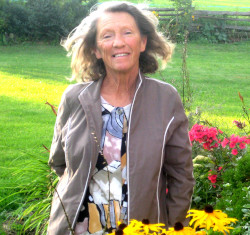
Elizabeth Lauder at Stanley Park
Photos: Abernathy & Smyth Publishing
The work of Elizabeth Cameron Lauder, a Canadian artist known for her oil on semi-precious stone and watercolors, is featured posthumously in two recently published softcover books: Elizabeth Lauder: Memoirs of a Plein Air Painter Volume One Watercolors (Abernathy & Smyth Publishing, $59.95) and Volume Two Oil on Semi-Precious Stone (Abernathy & Smyth Publishing, $69.95) edited by J.R. Boleyn, her life partner. Two additional volumes completing the series of four are scheduled to be published by year’s end.
Volume One includes 125 color images and Volume Two includes 200 images. Most pages feature a single image of her art. Many of the photos were taken and selected for inclusion by the artist, according to Boleyn who responded to questions via email.
“What defines Elizabeth, and separates her from other artists in that regard, was her ability to incorporate the stone itself as part of the final painting,” said Boleyn. “A prime example of that is the painting titled ‘Renaissance Girl’ (Volume One, page 117) where the wreath around the subjects head is the actual rubies embedded in the imperial jade stone. This made Elizabeth’s work unique in all the world, and why it became so valuable. She was the first!”

Elizabeth Lauder Volume One
All of her rock paintings in Volume Two and watercolors in Volume One have been previously sold to private collectors in over eighty countries. The artist owned a studio in Quartzsite, Arizona a town known for its international gem and mineral shows.
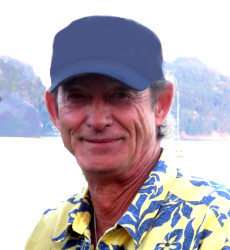
J.R. Boleyn, publisher, Abernathy & Smyth
“I have in my personal collection, which will be featured in her ‘Volume Three’ to be published by late summer, over 200 originals that will be for sale,” said Boleyn. “Yes, they are all watercolors, over 200 signed originals ranging in size from 8 x 11 to 22 x 30 and sizes in between, priced at a minimum $550 for the smallest to $4,500 for the larger sizes.”
According to promotional materials, she is a relative of film director James Cameron. Her work has been exhibited around the world and sold through Sotheby’s Fine Art Auctions and Sotheby’s Private Contemporary Artist’s Sales in New York and London. Her art has been collected by patrons in over eighty countries around the world, according to a press release that also indicates Elizabeth’s watercolors are currently under consideration for permanent exhibition in the National Gallery of Canada.

Elizabeth Lauder Volume Two
The art was compiled by Boleyn, an American songwriter, author, and founder of Abernathy and Smyth. Born April 8, 1948, in Ontario, Elizabeth’s first 18 years were spent growing up on a farm in the Caledon Hills where she was inspired by pastoral landscapes and abrupt and beautiful dramatic seasonal changes. Her formal education was completed in 1971 with an associate’s degree in sculpture from the Ontario College of Art and Design. The following year Elizabeth moved to the west coast, trading chisels and bronze for brushes and palette.
Already distinguished for her watercolors of Vancouver’s cherry blossoms, she spent the next seven years traveling throughout Mexico and painting southwest mining scenes. According to her website she was inspired by her travels to paint on massive slabs of semi-precious stone.
Comments:
Filed Under: Books
Posted by Elena del Valle on February 10, 2021
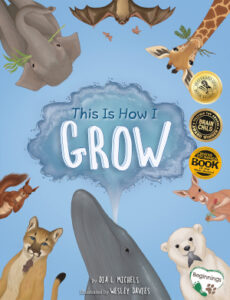
This Is How I Grow cover
Photos: Science, Naturally!
In 2020 Science, Naturally! released This is How I Grow,* a 51-page paperback book by Dia L. Michels for children ages seven to ten. A few months later Así Crezco, a 53-page paperback Spanish language edition of Dia’s book, was published. Full page color illustrations in both were by Wesley Davies. In the books Michels explores the growth process for mammals with short text and illustrations. The books are priced at $12.95 each.
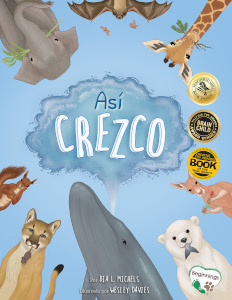
This Is How I Grow was translated by The Spanish Group, LLC. According to promotional materials, This is How I Grow received the 2020 Book of the Year award from Creative Child Magazine a Tillywig Brain Child award.
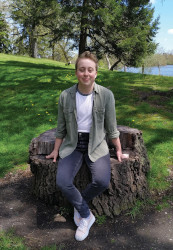
Illustrator Wesley Davies

Dia L. Michels, author, This Is How I Grow
Science, Naturally! is an imprint of Platypus Media , LLC. Michels, author of 12 books for adults and children, is publisher of Science, Naturally! This is How I Grow is her fourth science book. New England artist Davies specializes in illustration and comic art. These two titles are a book debut of his work.
*Print review copy and photos provided by publisher.
Comments:
Filed Under: Books
Posted by Elena del Valle on February 3, 2021
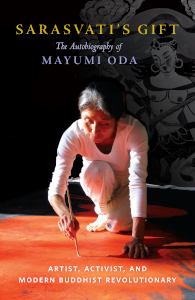
Saravati’s Gift by Mayumi Oda
Cover photo: Shambhala Publications, author photo: Cindy Whitehawk
Born in Tokyo, Japan in 1941 Mayumi Oda grew up in a war ravaged country. In time she married an American and became an artist and activist. In Sarasvati’s Gift The Autobiography of Mayumi Oda Artist, Activist, and Modern Buddhist Revolutionary (Shambhala, $22.95),* a 136-page softcover book published in 2020, the Hawaii resident shares part of her life story. The book includes 26 of her color illustrations each on its own page as well as family and personal photos.
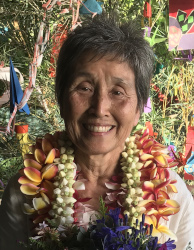
Mayumi Oda
In Chapter 1 she says she believes we are on the edge of disaster and at the same time poised for positive transformation. In the Afterword she shares her belief that toxicity is everywhere, that there is nowhere without pollution. She mentions having a stroke as she was completing her autobiography and as a result deciding she wants to dedicate the remainder of her life to writing and painting. She was unavailable to respond to email questions per a representative at the farm. A publishing company representative did not reply to email requests.
Oda, a painter, environmental activist, and Buddhist practitioner, describes her years in Japan, her marriage and the death of her son as well as her immigration to the United States, her inspiration and approach to art. In the 1990s, she started dedicating some of her time to activism pro women’s rights, antinuclear causes and anti genetically modified plants, and founded Gingerhill Farm on the Big Island of Hawaii, according to her biography.
*Print review copy and photos provided by publisher.
Comments:
Filed Under: Books
Posted by Elena del Valle on January 6, 2021
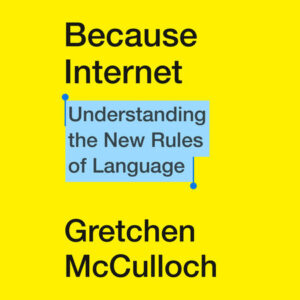
Because Internet
Photo: Riverhead Books
Ending a text with a period may make the writer seem old while an emoticon at the end of a sentence can add surprising nuance to the statement, according to a book about language published last year. The subtleties of informal written communication are many, says Gretchen McCulloch, a self described internet linguist. She believes modern digital communications are changing language and the way we and society overall communicate for the better. In Because Internet: Understanding the New Rules of Language (Riverhead Books, $26) she explains her views and theories.
Salutations like language in general evolve over time, according to the book. McCulloch explains that for many addressing someone with dear has become dated. At the same time hey, which for older generations is objectionable, has become a common written email greeting. Hi follows in popularity with hello being last and used to address strangers.
The author goes on to say that a generational gap exists; and some users embrace the “expressive capacity” of informal writing while others reject it. The author explains the difference between emoticons, emojis and gifs, pointing out that although there is no universal agreement on their appearance emojis are the best fit for many people communicating electronically. They make it possible for users to better express their mental states in written form, the author says. It’s useful to think of emojis as gestures; already courts have had to address the meaning of emojis such a raised hand, a possible gang sign or a comma, she says.
The 326-page hardcover book published in 2019 is divided into eight chapters: Informal Writing, Language and Society, Internet People, Typographical Tone of Voice, Emoji and Other Internet Gestures, How Conversations Change, Memes and Internet Culture and A New Metaphor. The emojis in the book are from Twemoji, an open source font released under a Creative Commons Attribution.
McCulloch, is based in Montreal, Canada and hosts the podcast Lingthusiasm, according to her bio.
Comments:
Filed Under: Books
Posted by Elena del Valle on October 21, 2020

Women in Biology
Photos: Science, Naturally!
Science, Naturally! released Women in Biology (Science Naturally, $9.95), a 40-page paperback for seven to ten year olds published this month. A hardback edition was published in 2016. The eight by eight inch book by Mary Wissinger is also available in a Spanish language edition titled Las mujeres en la biología. The books were illustrated by Danielle Pioli. Both books are available in digital formats.
Featured are Maria Sibylla Merian and Hildegard of Bingen of Germany as well as Jane Cooke Wright, Linda Buck and Barbara McClintock of the United States. There is a glossary at the end.
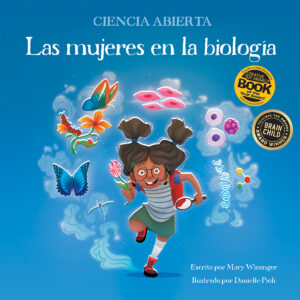
Las mujeres en la biología
The new titles are part of the publisher’s Science Wide Open series of “scientifically accurate children’s books” with a mission to teach young kids about Chemistry, Biology, and Physics, while highlighting some of the achievements of women in those fields. The biology books are the first ones in the series available in paperback and Spanish.
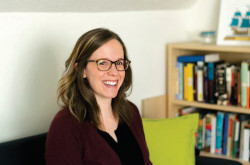
Mary Wissinger, author, Women In Biology
Wissinger was born in Wisconsin where she spent most of her childhood singing, reading, and daydreaming. A former teacher, she can often be found at her standing desk in St. Louis, Missouri, writing stories to inspire “curiosity about the world and connection with others.” She is the author of the entire Science Wide Open Series: Women in Biology, Women in Chemistry, and Women in Physics.

Danielle Pioli, illustrator, Women In Biology
Pioli is an artist and illustrator from Brazil who strives to inspire others to create. She produces art, illustrations, comics, zines, poems, songs, and hypnotherapy sessions. She is the illustrator of the entire Science Wide Open Series.
Science, Naturally! is Washington, D.C.-based independent press “committed to increasing science and math literacy by exploring and demystifying these topics in entertaining and enlightening ways.” The company uses fictional and nonfictional forms, diverse characters, and engaging formats to make intimidating subjects intriguing and accessible.
Comments:
Filed Under: Books
Posted by Elena del Valle on October 13, 2020
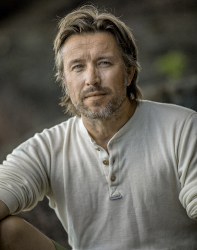
Torbjørn Ekelund, author, In Praise of Paths
Photo: Jørn H.Moen (2017)
A podcast interview with Torbjørn Ekelund, author, In Praise of Paths Walking Through Time and Nature, is available in the Podcast Section of Hispanic Marketing and Public Relations, HispanicMPR.com. During the podcast, he discusses the benefits of walking with Elena del Valle, host of the HispanicMPR.com podcast.
Torbjørn is co-founder of Harvest, an online magazine documenting wilderness adventures, environmental issues, and our relationship with nature. He lives in Oslo, Norway.
To listen to the interview, scroll down and click on the play button below. You can listen to it in the box marked “Podcast” on the right hand side. Select “HMPR Torbjørn Ekelund” and or download the MP3 file to your iPod or MP3 player to listen on the go, in your car or at home. You can also find it on the RSS feed. Some software will not allow flash, which may be necessary for the play button and podcast player. If that is your case, you will need to download the file to play it. To download it, click on the arrow of the recording you wish to copy and save it to disk. The podcast will remain listed in the October 2020 section of the podcast archive.
Posted by Elena del Valle on September 3, 2020
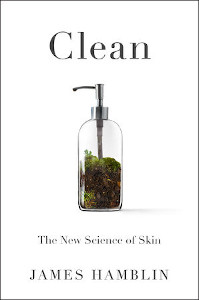
Clean
Photo: Penguin Random House/Riverhead Books
James Hamblin, a former radiology resident at the University of California Los Angeles turned health writer, begins the Prologue of his new book by letting readers know he hasn’t showered in five years. Several researchers and experts he interviewed indicated they too showered infrequently. He wets his hair daily and washes his hands, but he mostly stopped using soap on his body and shampoo, he said in the book. Beyond that there is little more to guide readers on the topic of showers and hygiene (other than a list of references at the end of the book).
In Clean The New Science of Skin (Riverhead Books, $28) he explores the history of soap and discusses beauty and cosmetic products at length, interviews researchers and wraps up with a discussion of toilets and public health. The 280-page hardcover book published this year is divided into: Prologue, Immaculate, Purify, Lather, Glow, Detoxify, Minimize, Volatile, Probiotic, Refresh and Epilogue.
In the Epilogue he points out that one of the most dangerous places to catch an infection is a hospital. Health care providers, he says, spread infections around hospitals. He points to government data indicating that one in every thirty-one patients in hospitals in the United States acquires an infection while at the facility. He suggests that what might make our skin look good is eating and sleeping well, keeping our anxiety under control and spending time in nature.
Based in Brooklyn, New York Hamblin is a staff writer at The Atlantic and a lecturer at the Yale School of Public Health. His first book, If Our Bodies Could Talk, addressed topics such as dimples, tattoos, getting rid of eyelashes, stomach rumbling and how to sit. Although he responded to an initial email he failed to respond to questions as of this writing.

Click to buy Clean
Posted by Elena del Valle on July 30, 2020

The Body A Guide for Occupants
Photo: Doubleday
In The Body A Guide for Occupants (Doubleday, $30) Bill Bryson, an American writer (born in Des Moines, Iowa) living in England, explores the human body. The 450-page hardcover book was published in 2019. Using some lesser known and unexpected tidbits he entertains readers with a curious and light exploration of some aspects of the human body, dispensing with gory descriptions. Often his discussion includes history and historic figures or quotes from authors, researchers and academics.
For example, in the chapter on Nerves and Pain he quotes Patrick Wall as a leading British neuroscientist and author of Pain: The Science of Suffering; and Oliver Sacks, who in a book on migraines described almost one hundred types of migraines. In The Outside: Skin and Hair chapter he quotes Peter Stark in Last Breath: Cautionary Tales from the Limits of Human Endurance, saying that a man who weighs 155 pounds has about 42 quarts of water in his body; and he will lose one and a half quarts of water a day via urination, sweat and respiration.
The hardcover book is divided into 23 chapters: How to Build a Human; The Outside: Skin and Hair; Microbial You; The Brain; The Head; Down the Hatch: The Mouth and Throat; The Heart and Blood; The Chemistry Department; In the Dissecting Room: The Skeleton; On the Move: Bipedalism and Exercise; Equilibrium; The Immune System; Deep Breath: The Lungs and Breathing; Food, Glorious Food; The Guts; Sleep; Into the Nether Regions; In the Beginning: Conception and Birth; Nerves and Pain; When Things Go Wrong: Diseases; When Things Go Very Wrong: Cancer; Medicine Good and Bad; and The End.
Bryson is author of 19 other books, including A Walk in the Woods, The Life and Times of the Thunderbolt Kid, and A Short History of Nearly Everything. He was chancellor of Durham University, England’s third oldest university, from 2005 to 2011, and is an honorary fellow of Britain’s Royal Society.
According to his FaceBook page he met his wife in England, where they settled; he wrote for The Times and The Independent before moving back to the United States with his wife and four children. He and his family moved back to England in 2003.
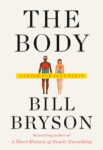
Click to buy The Body: A Guide for Occupants
Posted by Elena del Valle on July 6, 2020
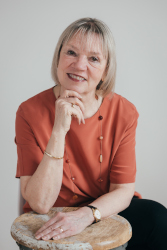
Susan J. Douglas, author, In Our Prime
Photo: H. Nash
A podcast interview with Author Susan J. Douglas is available in the Podcast Section of Hispanic Marketing and Public Relations, HispanicMPR.com. We will discuss her new book In Our Prime: How Older Women are Reinventing the Road Ahead (W.W. Norton and Company, $25.95).
Susan is the Catherine Neafie Kellogg Professor and Arthur F. Thurnau professor of Communication and Media at The University of Michigan. In Our Prime was recommended as an “Editors’ Choice/Staff Picks” by The New York Times and hailed by the Associated Press as a “masterful takedown of gendered ageism.” She is author of Celebrity: A History of Fame, The Rise of Enlightened Sexism: How Pop Culture Took us from Girl Power to Girls Gone Wild; The Mommy Myth: The Idealization of Motherhood and How it Undermines Women with Meredith Michaels; Listening In: Radio and the American Imagination, which won the Hacker Prize in 2000 for the best popular book about technology and culture; Where The Girls Are: Growing Up Female with the Mass Media; and Inventing American Broadcasting, 1899-1922.
To listen to the interview, scroll down and click on the play button below or locate the “Podcast” section on the right hand side, then choose “HMPR Susan J. Douglas” or download the MP3 file to your iPod or MP3 player to listen on the go, in your car or at home from the RSS feed. Some software will not allow flash, which may be necessary for the podcast player. If that is your case, you will need to download the file to play it. To download it, click on the arrow of the recording you wish to copy and save it to disk. The podcast will remain listed in the July 2020 section of the podcast archive.
Click to buy In Our Prime
Posted by Elena del Valle on June 8, 2020
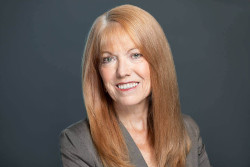
Engelina Jaspers, author, Marketing Flexology
Photo: Curtis Myers
A podcast interview with Engelina Jaspers, author, Marketing Flexology (Flex Pro Media, $26), about the need for marketing agility is available in the Podcast Section of Hispanic Marketing and Public Relations, HispanicMPR.com.
Over a rewarding 30-year corporate career, Engelina experienced revolving-door CEOs, business course-corrections and lots of reinventions. After leading multiple company wide transformations, she learned what separates the career winners from the career losers during change and transformation. She shares what she’s learned through customized workshops, presentations, consulting engagements and her book.
To listen to the interview, scroll down and click on the play button below or locate the “Podcast” section on the right hand side, then choose “HMPR Engelina Jaspers” or download the MP3 file to your iPod or MP3 player to listen on the go, in your car or at home from the RSS feed. Some software will not allow flash, which may be necessary for the podcast player. If that is your case, you will need to download the file to play it. To download it, click on the arrow of the recording you wish to copy and save it to disk. The podcast will remain listed in the June 2020 section of the podcast archive.
Click to buy Marketing Flexology































